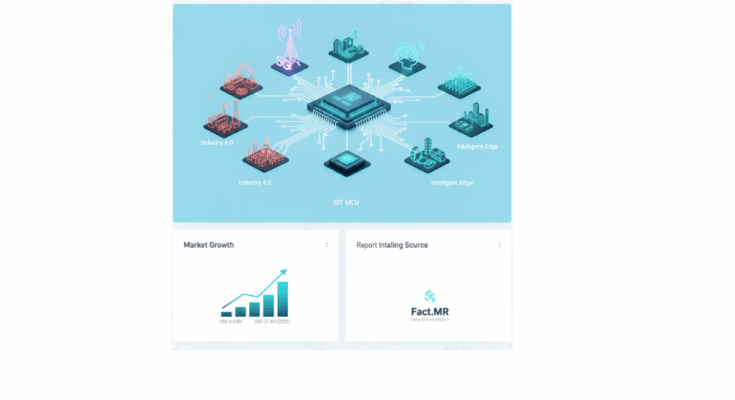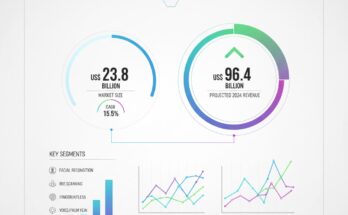The global IoT Microcontroller Market is entering a transformative growth phase, with revenues expected to rise from USD 6.4 billion in 2024 to USD 27.4 billion by 2035, according to a new data-driven report by Fact.MR. Propelled by the convergence of AI, 5G infrastructure, and Industry 4.0, IoT microcontrollers (MCUs) are emerging as the cornerstone of intelligent edge ecosystems — enabling real-time sensing, ultra-low power operation, and secure data processing across a rapidly expanding range of connected applications.
IoT Microcontrollers: The Engine of Intelligent Connectivity
Microcontrollers have evolved beyond their traditional role as processing units to become strategic enablers of smart ecosystems. These compact, low-power chips now provide computation, communication, and control for connected devices spanning consumer electronics, industrial automation, automotive systems, and healthcare.
In the age of hyper-connectivity, IoT microcontrollers allow devices to sense, decide, and act at the edge — a critical capability for responsive and scalable IoT architectures.
As global demand for smart homes, wearable technologies, and connected industrial systems accelerates, the market for multi-purpose and secure MCUs is expanding at an unprecedented rate. The next decade will see manufacturers integrating wireless communication standards (Wi-Fi, Zigbee, Bluetooth) with enhanced cybersecurity features, addressing rising concerns over data protection and device integrity.
Key Market Drivers: Edge AI, 5G, and Automation
The Fact.MR report identifies three pivotal forces shaping the IoT microcontroller landscape:
-
Explosion of Connected Devices:
With billions of IoT-enabled endpoints projected globally, demand for embedded intelligence and low-latency decision-making has surged. MCUs now power mission-critical applications in manufacturing, logistics, and healthcare, where real-time responsiveness is essential. -
Edge AI Integration:
Manufacturers are embedding AI and machine learning capabilities directly into microcontrollers, enabling localized analytics for predictive maintenance, voice recognition, and sensor fusion. These advancements significantly reduce cloud dependency and improve operational efficiency. -
Rise of Ultra-Low-Power Design:
Energy efficiency has become a defining differentiator. Ultra-low-power microcontrollers are enabling long-lasting battery-operated IoT deployments — from environmental sensors and fitness trackers to remote medical devices — driving adoption in sustainability-conscious markets.
Overcoming Challenges: Complexity, Power Constraints, and Standardization
Despite its strong growth trajectory, the IoT MCU sector faces design complexity and integration challenges. Supporting multiple connectivity and security protocols has raised development costs and time-to-market pressures.
Fragmentation in industry standards also complicates interoperability across heterogeneous IoT ecosystems. Moreover, semiconductor supply chain disruptions and shortages of embedded system engineers have exposed vulnerabilities that manufacturers must address through strategic partnerships, modular architectures, and green innovation.
Regional Insights: North America and East Asia Lead Innovation
North America:
The U.S. IoT microcontroller market is forecast to achieve USD 5.7 billion by 2035, driven by AI convergence, 5G rollout, and a robust focus on industrial automation and cybersecurity compliance. Legislative initiatives like the IoT Cybersecurity and Enhancement Act have spurred adoption of secure design practices in defense, healthcare, and smart infrastructure.
East Asia:
China, Japan, and South Korea dominate the East Asian landscape, driven by strong electronics manufacturing bases and government-backed semiconductor initiatives.
-
China’s growth is underpinned by national semiconductor self-reliance goals and the proliferation of IoT devices across 5G networks.
-
Japan’s IoT ecosystem, aligned with its Society 5.0 vision, integrates AI and IoT to transform industrial automation and consumer electronics.
-
South Korea continues to expand smart city and autonomous vehicle programs, accelerating domestic MCU innovation.
Western Europe:
The European market remains a mature yet security-driven hub, with strict GDPR-compliant frameworks and Industry 4.0 transitions demanding secure, interoperable MCUs. Germany and France are leading in industrial automation adoption, emphasizing energy-efficient and high-security architectures.
Category and Application Outlook
The market is segmented by architecture, connectivity, and application, highlighting several high-growth domains:
-
32-bit Microcontrollers dominate due to their capability to handle AI and ML workloads, supporting applications like smart cities, autonomous systems, and industrial machinery.
-
Short-range wireless MCUs lead the connectivity segment, powering smart homes, wearables, and portable devices through Wi-Fi, Bluetooth, and Zigbee integration.
-
Enhanced security MCUs are witnessing exponential growth amid rising cyber threats, particularly in healthcare, automotive, and energy sectors.
-
Ultra-low-power MCUs are gaining traction in battery-reliant IoT deployments, aligning with global sustainability trends.
-
Industrial IoT (IIoT) remains the fastest-growing application, with manufacturers deploying MCUs for real-time analytics, automation, and predictive maintenance.
Healthcare: The Next Frontier
The healthcare sector is emerging as a crucial driver of IoT MCU demand. Applications in connected diagnostics, patient monitoring, and medical wearables are growing rapidly, supported by the shift toward personalized and remote healthcare ecosystems. The need for secure, long-life, and precision microcontrollers is fueling partnerships between semiconductor companies and medical device manufacturers.
Competitive Landscape: Innovation, Integration, and Security
The IoT microcontroller market is highly competitive, featuring global leaders such as Texas Instruments, STMicroelectronics, NXP Semiconductors, Infineon Technologies, Microchip Technology, Renesas Electronics, Broadcom, and Silicon Labs.
Recent breakthroughs include:
-
Texas Instruments’ MSPM0C1104 (March 2025) — the world’s smallest wafer chip-scale MCU (1.38 mm²) for medical wearables and earbuds.
-
STMicroelectronics’ STM32N6 Series (Dec 2024) — the company’s first edge-AI MCU family, enabling on-device image and audio processing.
Companies are differentiating through low-energy design, Matter protocol integration, and AI-ready architectures, while strategic collaborations between chipmakers, IoT developers, and cloud service providers are shaping future standards.
Fact.MR Methodology: Data Depth Meets Strategic Precision
Fact.MR’s 2025 IoT Microcontroller Market report draws on insights from over 8,250 industry stakeholders across 25 countries, applying multivariate modeling, cluster analysis, and time-series forecasting to capture real-time ecosystem shifts.
This research is a mission-critical resource for semiconductor manufacturers, IoT solution developers, investors, and policy strategists seeking to harness the next decade of IoT hardware evolution.
Browse Full Report : https://www.factmr.com/report/lot-microcontroller-market



